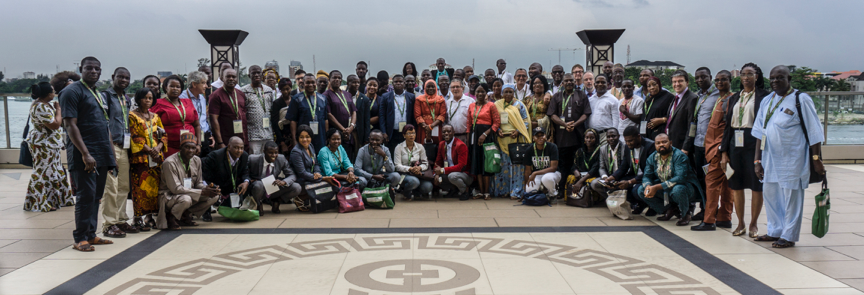By: Durodola Owoade, International Institute of Tropical Agriculture (IITA), GREAT Fellow

Group picture with GREAT representative Durodola Owoade (front row, fifth from right) and Tessy Madu (back row, far left)
Among the important staple food crops, cassava is nothing short of a powerhouse. Because of it, smallholder farmers have been able to feed their families and control domestic demands through income from cassava production. Though many obstacles stand in the way of most cassava producers in West Africa, there is a great need to overcome the fear of risk in order to increase production. It is particularly important to train individuals to create a positive future for cassava production and processing.
In order to address this, great support from gender teams was given to farmers, producers, and other colleagues in the field to participate in the 2017 AgraInnovate and CassavaTech conferences, held in Lagos, Nigeria, November 21-23, at the Landmark Center and Oriental Hotel, respectively, where heated debates on challenges hindering the success of cassava production operations, likely solutions, abstracts, and posters presentations from brilliant minds were presented and discussed.
The challenge of scaling cassava production
Different stakeholders along the cassava value chain were invited to the conference to dialogue about progress so far, the present state of the industry, and share their stories about success in cassava production. Given rising unemployment rates, there exists a pressing need to upscale cassava production in order generate income parallel to the economy. Farmers invest significant time and energy into production, but due to lack of innovative ideas and training, their profits fall short, and their production can slow down. By undergoing the series of agricultural education on integrated soil fertility management and good agricultural farming practices through IITA (International Institute of Tropical Agriculture) innovative training, more young farmers can spring up and become entrepreneurs.
Multiple series of ideas were discussed with topics ranging from cassava production profitability, cassava processing, drying innovations, cassava as livestock feed, and bioenergy from cassava waste. The conference highlighted common challenges facing many African farmers, including the unavailability of land. A high percentage of farm lands are owned by small-scale farmers, which results in highly scattered farmland for small producers across many countries, while many large hectares of farm lands are established for industrial purposes in order to produce large-scale processing cassava into high-value products.
Cost of production and the use of conventional methods of farming requires more money, which needs wheels of change to mechanized farming in order to save more time, generate more profitable outputs and covers more farming areas. The issue of poor road networks is another major challenge faced by farmers, and coupled with the low shelf life of cassava, has greatly discouraged large-scale production in order to avoid loss of roots before they can be sold. These issues, along with inconsistency of policymakers on implementing the use of cassava flour as a substitute for wheat flour, are collective hindrances discouraging individuals from cassava production.
A suitable production solution
Necessity is the mother of invention, and sustaining cassava production as a means of livelihood for impoverished people is highly imperative, because it has been shown that this crop can be one of the major driving forces in lifting many people out of poverty. Upscaling production and preserving cassava requires increasing land availability, so that both farmers and individuals should save money to acquire farm lands. Farmers with common interests should come together and harmonize their resources and assets to form larger collective hectares of farmland. By doing this, they would be able to meet the high market demand for fresh roots.
Next, industries should form alliances with farmers to support their income, and also to encourage other people to enter into cassava production. Farmers should forge a network through which to share ideas and help young farmers prevent loss. Government should support only cluster farmers (a collective network of smallholder producers) and create more consumer awareness about the nutritional benefits of cassava. The CassavaTech mobile app would also promote sales of cassava roots.
The app provides direct-to-user information about prices, farm inputs, and food products and quality, enabling farmers and industries to choose their markets and optimize revenue. The role of middlemen would thus be unnecessary, increasing direct revenue for farmers. The app is available for all android phone types. Its interface is user-friendly and can be used to discover price trends and to exchange SMS messages with farmers about their products, locations and markets, directly linking the consumer to the farmers’ products.
Besides economic considerations, farmers should be encouraged to explore renewable energy as an alternative to other energy sources. Patrick Ogbuinya, a representative of the IFAD Value Chain Development program in Nigeria, was one of the participants at the conference, and he spoke about his experience in successfully converting cassava peels, fermented water waste and other animal waste into biofuel, using this as a fuel source for cooking. The use of cassava peels may not be enough to generate biofuel, so water waste from the fermentation process is a good source of energy for lighting and cooking, and can be a sustainable alternative to firewood in toasting cassava cake into garri.
He stated proudly that for the past seven years, he has generated energy through cassava peels and other similar waste products in his home. Bioenergy is produced through a bio-digester, which converts different kinds of waste into fuel. This alternative energy method also offers the benefit of reducing deforestation.
Finally, farmers should collaborate to open road access to their farmlands and properties for collective benefit. Mechanization should be prioritized: farmers should be encouraged to use machines and newer technology to carry out their farming practices. A prototype of a ploughing machine should be created, and made so that it is easy to attach to tricycle-style machine with strong wheels to withstand wet soils. Its manufacturing should be gender-sensitive so that women farmers can effectively use it. New farmers and processors should adopt franchising marketing strategies, which would promote their sales and yield rapid growth. Lastly, government should promote the use of 10% cassava flour for bakery and other confectioneries.
If carried out successfully, the ideal outcome is that more farmers would be interested in innovative and gender-responsive farming practices, and thus millions of people in Africa could be lifted out of poverty.
About the author: Durodola Sakirat Owoade, from Nigeria, is a research supervisor for IITA who is involved in hybridization and data collection. Durodola’s passion for agriculture started when she was a student intern curious about what made cassava roots so big, even bigger than yams. The importance of cassava in Nigeria motivates her to breed new varieties for end users and interact with farmers. She has a BSc in Plant Science from Olabisi Onabanjo University, in Nigeria, and is the mother of two children.





